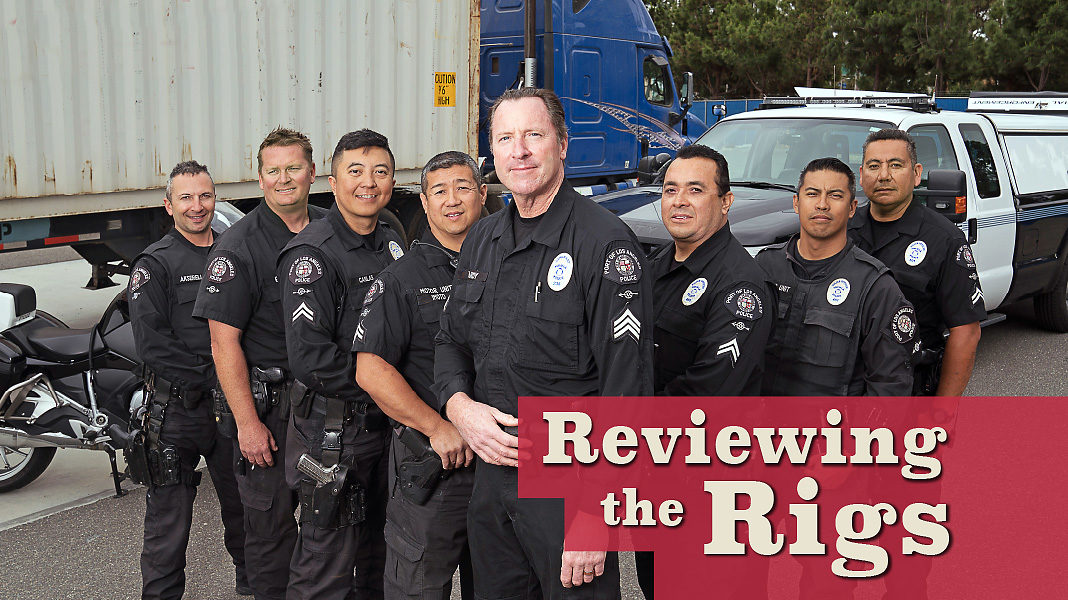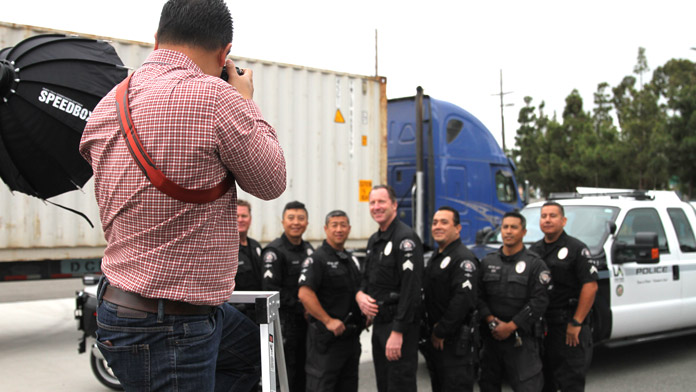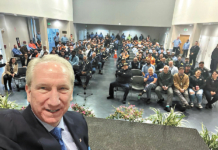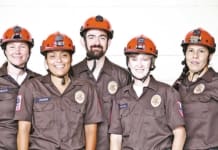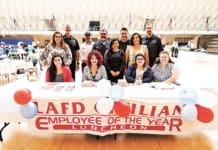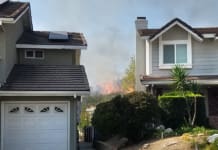Photos by Summy Lam, Club Director of Marketing,
and Alive! editor John Burnes
Port Police’s Commercial Enforcement Unit inspects cargo trucks to keep streets and neighborhoods safe and freight moving.
America’s Port, the Port of LA, is one of the busiest and most productive areas of Los Angeles, and in the whole country. The challenge for the Port Police is to keep the commerce moving safely, legally and smoothly.
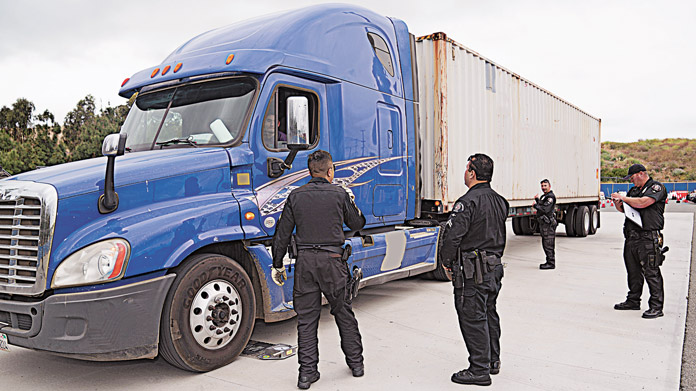
Between 5,000 and 7,000 commercial trucks come into and out of the Harbor every day, and it’s the job of the Port Police’s Commercial Enforcement Unit to make sure those trucks are within weight, height, registration and maintenance regulations. It’s a tall job for the eight Officers and one Sergeant.
Their commercial enforcement method contains two steps – visually eye-balling the trucks coming into and leaving the Port for the telltale signs of being out of compliance, and then isolating the vehicle by the roadside or in the Port Police’s inspection lot on Front Street for a thorough, meticulous inspection to clear, or cite, the vehicle.
The unit is the City’s primary Commercial Enforcement force, although it works in direct coordination with the LAPD and many other agencies, including the CHP, and police forces from Torrance, Beverly Hills, Riverside, the LA County Sheriff’s Office, and others.
Commercial Enforcement is not all the unit does. It’s the Port Police’s only motorcycle unit, so traffic patrol and crowd management are also its responsibilities. Needless to say, with the Port continuing to grow, the unit stays very busy.
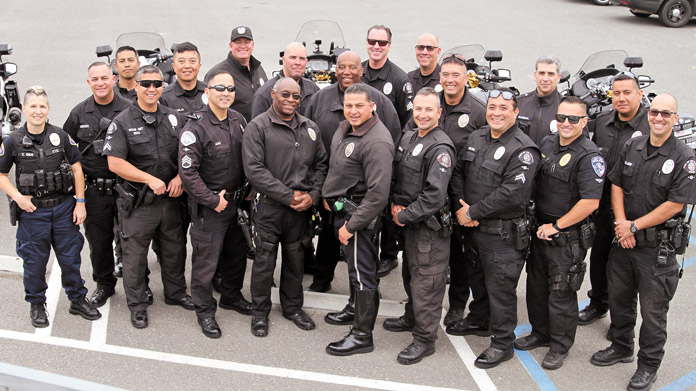
In this month’s feature, Alive! talks to the officer in charge, Sgt. Glenn Twardy, Club Member, 22 years of City service, to learn the many details of the Commercial Enforcement Unit. And then we check out an inspection training exercise to see how it all works.
Thanks to Sgt. Twardy and Port Police Commercial Enforcement Unit for hosting us and demonstrating how they’re keeping the Port safe and moving.

The Port Police held a regular training session May 8 and demonstrated to Alive! how a typical commercial vehicle inspection would work. This is how the training exercise went down.
 Determining Vehicle Weight
Determining Vehicle Weight
Port Police Officer Morgan Evans, 11 years of City service, Club Member, takes out the mobile scales. These are then placed under the truck’s tires to determine vehicle weight.
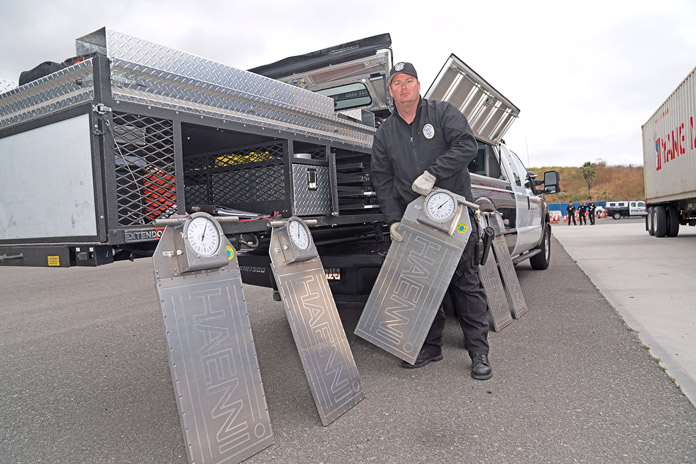
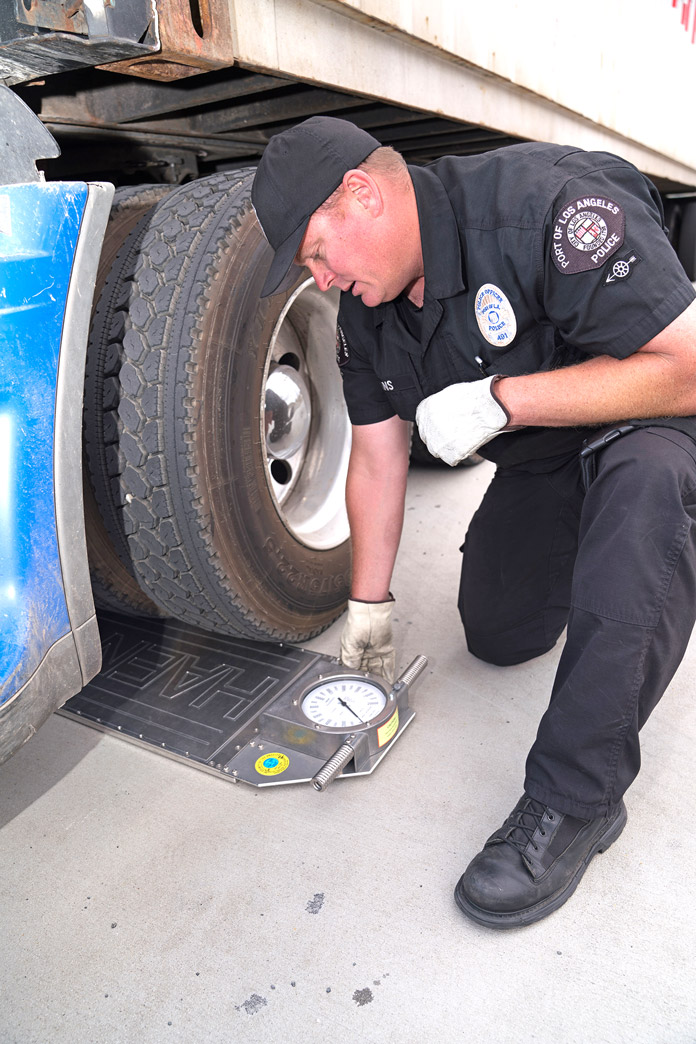
 Determining Vehicle Height
Determining Vehicle Height
Port Police Officer Arman Akserelian, 10 years of City service, measures the height of the commercial truck.
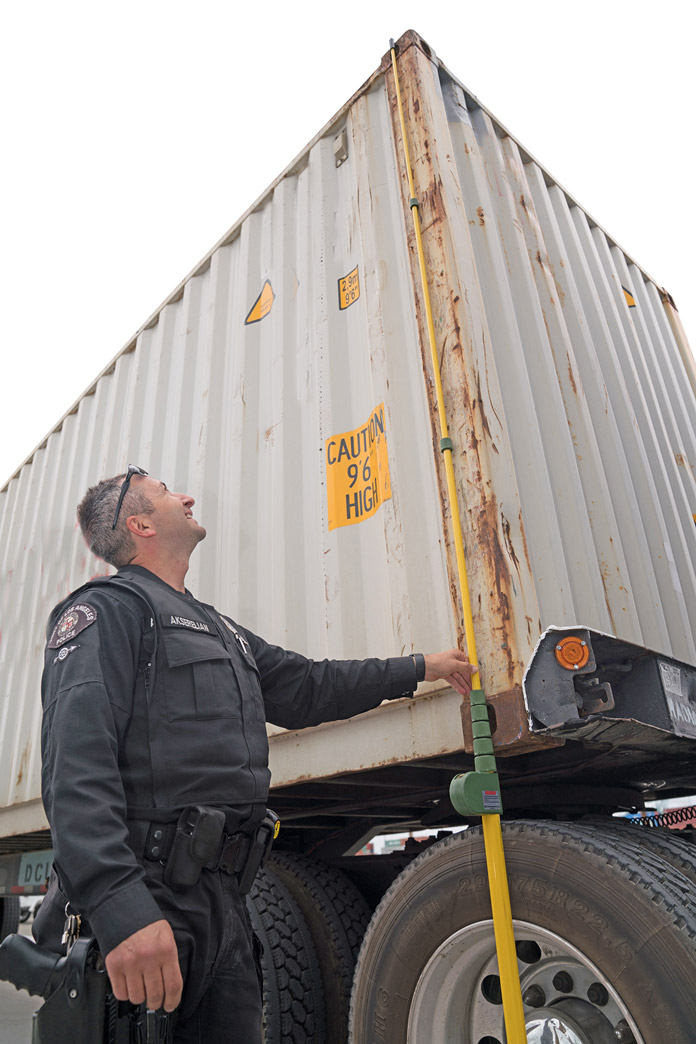
Port Police Officer III Michael Canlas, 15 years of City service, Club Member, measures the vehicle’s length.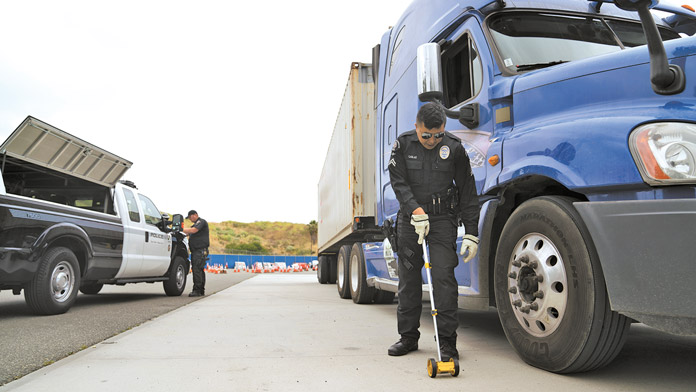
 Checking Under the Hood
Checking Under the Hood
Port Police Officer Arman Akserelian checks under the hood and verbally reports his findings to Port Police Officer III Michael Canlas (off camera), who records them on a sheet.
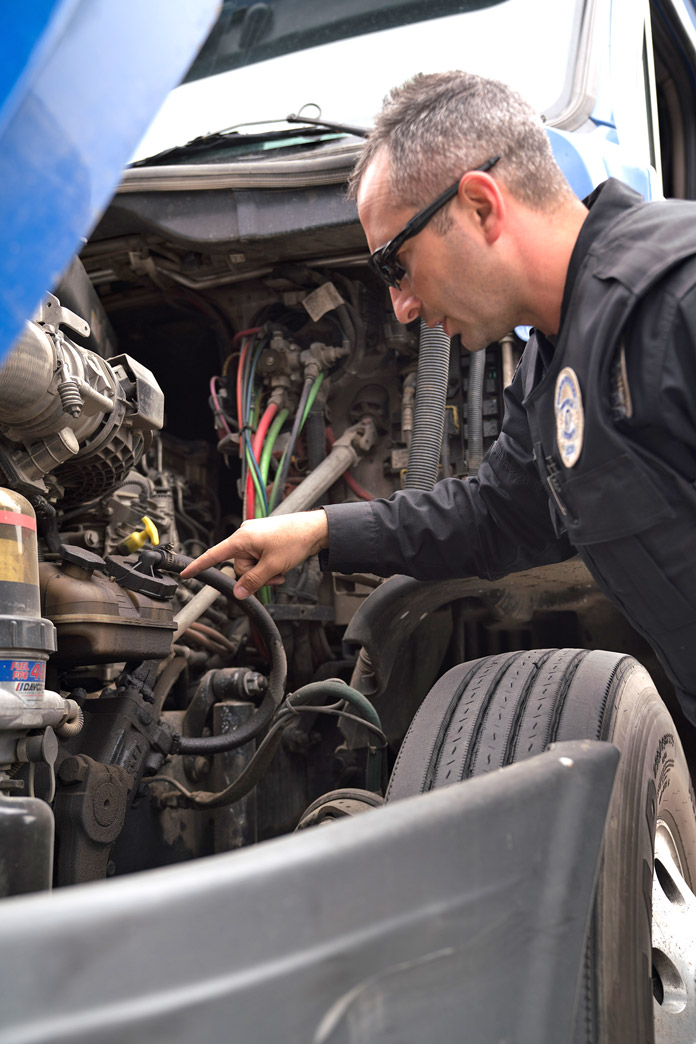
 Inspecting Under the Vehicle
Inspecting Under the Vehicle
Port Police Officer Michael Canlas checks under the vehicle and behind the cab for the condition of brakes, lines, structure, suspension, and other elements.
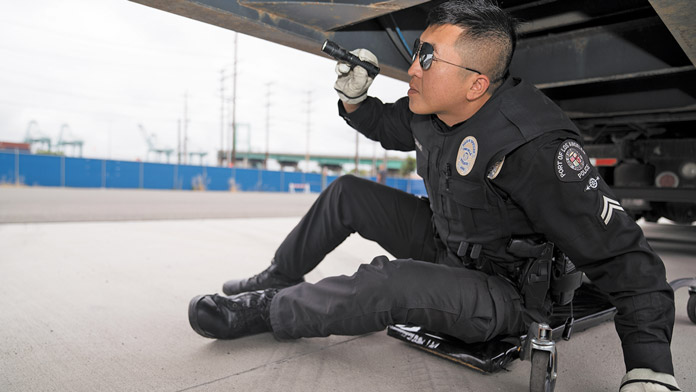
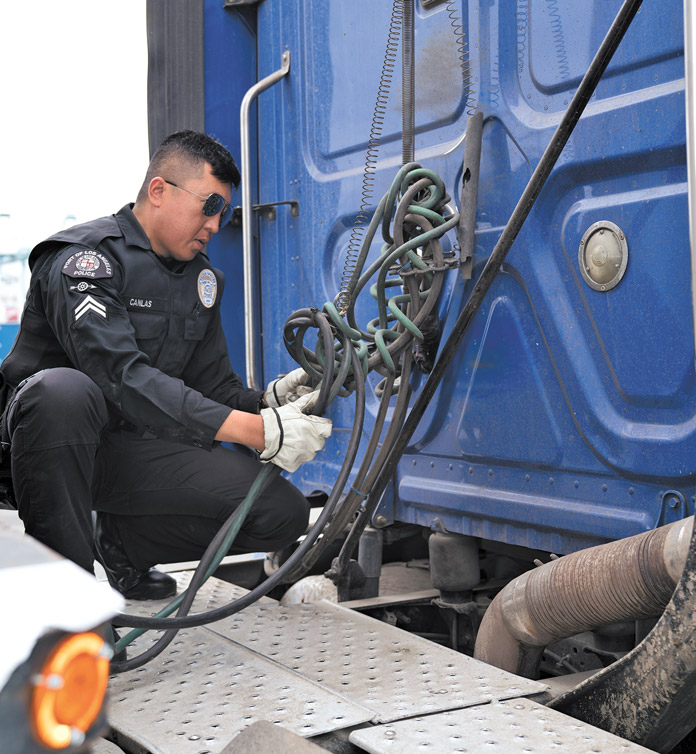
 The Inspection Report
The Inspection Report
Port Police Officer III Mark Renteria, 20 years of City service, Club Member, adds figures into the inspection report.
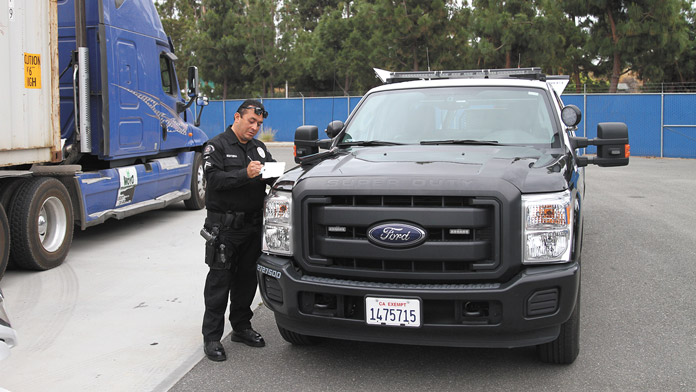
Safety Is Paramount
On Friday, May 3, Alive! editor John Burnes interviewed Port Police Motor Sgt. Glenn Twardy, supervisor of the department’s Commercial Enforcement Unit, which inspects commercial vehicles in and around the Port of LA. He has worked for both the Harbor Dept. and Rec and Parks. The interview with Sgt. Twardy, 26 years of City service, Club Member, took place over lunch in San Pedro.
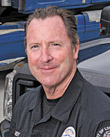 |
Thanks for speaking to me today before we shoot your training inspection. First, how did you get involved in public safety?
Sgt. Glenn Twardy: I started full time in 1993 as a Detention Officer, and then full time with the LA City Park Rangers in 1996. I was a Park Ranger through 2004, and I came here in April 2004.
Where were you assigned as a Park Ranger?
The Metro region, the Pacific region and then the last two years out of Griffith Park.
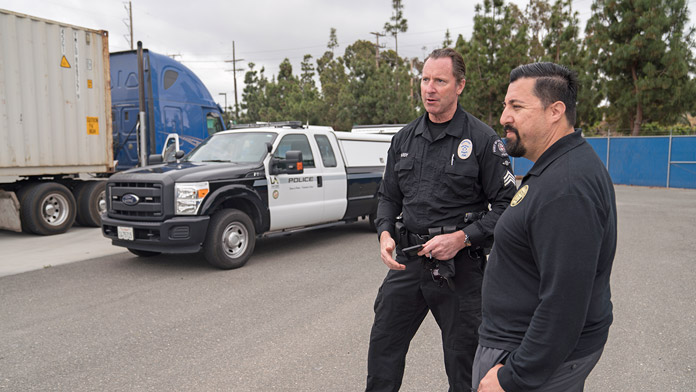
What did you do?
General patrol, search and rescue, fire suppression, and that the last two years collateral mounted.
And then you left for the Port Police.
Correct. I was with the Rangers for eight years and had done all the special assignments. I also conducted bicycle patrol. I just didn’t know if I could do that for another 12 to 17 years. It was fun. I enjoyed it; don’t get me wrong. A friend who I worked with at the Rangers had come down to the Port Police. He had been courting me for a couple of years, so finally one day I just literally came for ride along with him and made that decision.
What made you want to be in law enforcement? Has it always been a dream?
No, it was actually by chance. After college I was playing minor league baseball with the Seattle Mariners organization.
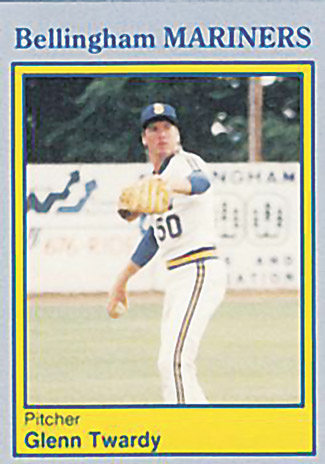
What position?
Pitcher. I played outfield in college and then they converted me to a pitcher.
How far did you make it?
Out of spring training I made the AA [double-A] and then I got hurt right out of spring training, so that was the end of that.
Did you blow out your arm?
Yes, exactly.
What was your best pitch?
Probably my slider.
I had a good run in college. I went to Cerritos College. We were the state champs. And then I went to Long Beach State and played in the College World Series.
Well, I’m impressed.
Thanks. That was kind of cool. But getting into law enforcement was strictly by chance. I didn’t grow up wanting to be a cop. But I needed a job between baseball seasons. You don’t make much money in the minor leagues. There was a park patrol position open. I had friends working there. I worked and went back to spring training, and that’s when I got hurt. I fell back on that part-time job. When they opened it up full-time, I took the City exam and was on full-time.
How did you get into this unit? And how did you become a Sergeant in charge of it?
Basically, they asked, “Who’s interested in riding a motorcycle? We’re going to create a motorcycle unit.” One of my Motor Officers who is still in the unit, Officer III Masaki Imoto [Club Member], and I were picked to go first. We attended the LAPD’s motorcycle school. After the first week I had my father stay with me and he was elderly and ill. So I had to drop out of that school. Masaki graduated and was the first Port Police Motor Officer. Two others and I went four months later. We were the first core four
About the Unit
Let’s talk about the Commercial Enforcement Unit.
Sure. It’s comprised of eight riding Motorcycle Officers and myself – nine total.
Give me an overview of what your unit does.
The unit does traditional motorcycle enforcement work: speeders, illegally parked vehicles, traffic control and traffic collision reports. Port Police takes care of its traffic control needs with our Special Events Unit down here. The Harbor Dept. hosts probably more than 100 special events a year now. We have two parks. They’re redoing Ports O’ Call. Cirque du Soleil is in town, so our guys are doing traffic control for that. On cruise ship days we have 7,000 people leaving the cruise terminal and 7,000 arriving. That’s a traffic challenge. And we have trucks bringing food and other perishable items that have to be escorted in.
So it’s busy.
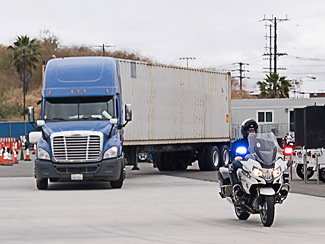
I’d say.
It’s traditional police work on a motorcycle. And now the emphasis of our unit is looking for oversized commercial vehicles – overweight, over-length, over-width, over-height.
Are you the only motorcycle unit in Port Police?
Yes. We’re the only commercial unit within Port Police. Commercial Enforcement is its own unit.
Got it.
Inspections
What actions do you take for commercial inspection? What does that look like?
It’s visual probable cause. Because we’ve gone through the CHP Commercial Enforcement School and we are full-time traffic officers, per California Vehicle Code 2802 (a) VC, we can legally pull a vehicle over if we suspect it is not safely loaded or that the height, width, length or weight of a vehicle is unlawful.
Is there a central tunnel or a central exit that all commercial vehicles leaving the Port have to go through that makes your visual easy?
No.
So it’s just what you see on the road.
The Port stretches from San Pedro to Wilmington. And what makes this Port so unique is – although the Port terminals are private property, they exit onto public access roads and streets. That’s different than Long Beach, where you can set up in one or two locations and see all the trucks coming by. The Port of LA is a lot different than that. It’s a lot of self-initiated proactivity.
Our guys are experts out here. We have 5,000 to 7,000 trucks per day coming in and out of the Port.
That’s a lot of vehicles to leave the Port.
Yes. The bottom line for us is that we are here to maintain that free flow of commerce. If you get a truck that’s not within regulations or not inspected properly, at some point it will break down on the Vincent Thomas Bridge, and that creates tremendous backup. This Port has business and residential. You’ve got all of the longshoremen who need to get to work. You’ve got residents who need to get home and pick up their kids. And, you have another 10,000 trucks coming behind this one. Safety is definitely paramount. The truck has got to be mechanically sound so it doesn’t break down in or around the Port.
What do you check?
We’ll do our visual inspections on the road. If one looks suspicious or not quite right, then you direct that vehicle into a vehicle inspection lot, where we do the physical inspection. We’ll get under the truck, check the brake lines, the steering columns, the air pressures, things like that. We get on what we call a creeper – inspectors are on their back rolling around under the truck.
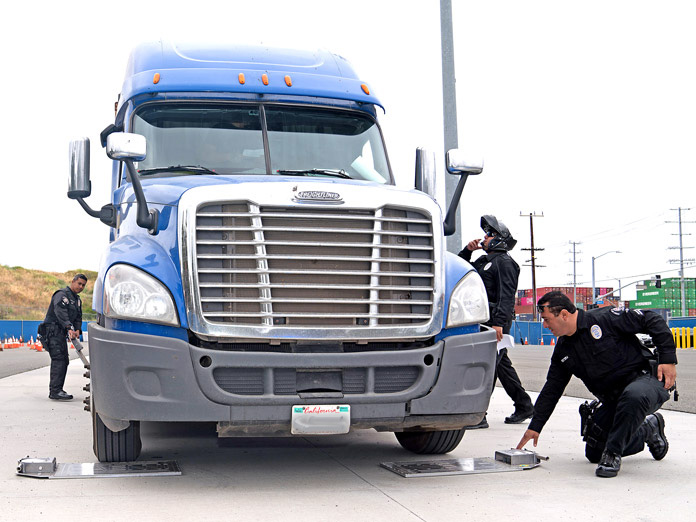
Do you pop the hood to check the steering?
Yes. Underneath the hood we check a lot of things.
Are these state regulations? Federal regulations?
Both. Some of these tickets you cross-reference all of them. They can get pretty complicated. But then, again, some of these overweight citations can run the owner anywhere between $2,000 and $20,000.
Per infraction?
Per violation.
Do they try to trick you? Do they lower the inflation on their tires to lower the height of the vehicle, for example?
No, not really. That will just flatten, or square off, the bottom of the tire. One of the visual indicators of extra weight is squared-off tires. If they lower it, that’s a real indicator. It’s actually one of the primary visual indicators if you’re looking for an overweight.
What other indicators are there?
We listen to the revving of he engine, the RPMs. Not so much anymore because these trucks are considered clean trucks. But before you used to watch the smokestack. If it was bellowing a lot of smoke, that meant the engine was really working; that was another indicator.
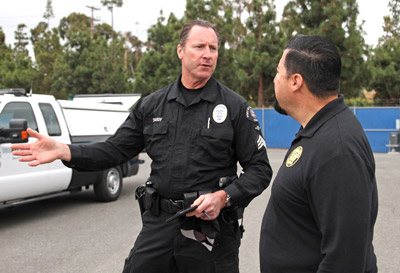
Are there other aspects of commercial enforcement? Paperwork, training, that sort of thing?
Yes. The commercial school at the CHP in Sacramento used to be 80 hours. They condensed it, I think, when the recession hit hard times. It’s now condensed to 40 hours. And then we do so refresher courses. Irvine puts on a good refresher course for commercial.
We work really well hand-in-hand with LAPD’s SES, their Special Enforcement Section. That’s their Commercial Enforcement team. It’s little different from us, though – there are only 13 of them, and they get called to do escorts and all kinds of other things, and teaching motor school. Without diminishing what they do, for all intents and purposes this is the only full-time Commercial Enforcement unit in the City.
History
What’s the history of the Port’s Commercial Enforcement? How did this come about?
The unit started in 2005. The way it was told to me, from about 2000 to 2004 people in Wilmington – the Neighborhood Councilmembers and residents – had ongoing complaints about quality-of-life issues. These trucks were going through neighborhoods and taking shortcuts through residential areas and by schools. Pressure was put on the Harbor Dept., and the Harbor Dept. responded and did the right thing. They created a motorcycle unit that pretty much morphed into the Commercial unit. From the inception, our job was to monitor these trucks and monitor the areas where the community of Wilmington was encroached upon heavily from Port activity.
Has there been a difference once you were more proactive in the enforcement?
Yes, absolutely. We got tremendous positive feedback that first year. I didn’t necessarily know the difference because I had just gotten here. But I was told by community members and even some of the Officers that, yes, we got a bunch of, “What a big difference you guys have made.”
Why It Matters
Why is Commercial Enforcement important at the Port of LA?
There are different parts to that answer. Starting on the docks, when those freight containers are taken off the ship, they’re loaded onto a truck chassis and they lock the corners. Is it locked down? If that container falls off, you, our loved ones or me could be driving next to that thing.
Then the next part of it is checking to see if the truck is mechanically sound. If the brakes are rated for 80,000 pounds and they load 120,000, now you have potential for catastrophic mechanical failure, which then results in loss, whether it’s property damage or the ultimate loss of life. And then we look at the road infrastructure – roads are engineered for weight maximums. That’s why we weigh them – each axle is designated a certain amount of weight. It’s that bridge weight that causes the potholes or hits a small pothole and makes it bigger because there’s just too much weight on that axle that digs in. So now we’re talking about road infrastructure. If you and I are driving and we hit a pothole that was created by the truck, either our tire blows out or we’ve got to go get an alignment.
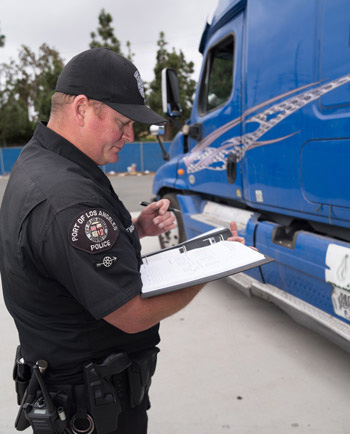
Or worse.
Or worse. It’s a trickle-down effect.
But, ultimately, it’s for the safety of vehicular and pedestrian traffic. In this Port complex you are mixing 80,000-pound trucks with motorcyclists and teenage drivers and school buses. That’s not to say they aren’t mixed anywhere else, but it’s magnified here because these trucks are right next to cars going over the bridge or right next to school buses, and there’s no separation of the two.
It could cause loss of life, loss of infrastructure, loss of time.
To this day the number one injury on the docks is overweight containers. The infraction goes to the owner, not necessarily the driver, unless the driver owns the vehicle. It is the owner’s responsibility. Our City Attorneys do a tremendous job in collecting the fees of the violations.
To us, it’s about public safety.
How often are there major incidents – not just a failed inspection but a rollover?
Sometimes we’ll get six a month, sometimes we’ll not get any. On average it’s roughly three rollovers a month.
Tell me about one, if you can.
Years ago there was a truck that left the Port. It was going up Alameda into Carson. The truck rolled over and a poor guy who was riding his bicycle alongside of it got smashed. I tell my loved ones, I’ll tell you and all the Club Members out there – avoid being next to these trucks on the freeway. One, you don’t know the condition of that truck. Or if the driver’s got to do a quick emergency maneuver if someone cuts him off, you don’t know how well that container is put down.
The Future
As the Port continues to grow, what’s the future of Commercial Enforcement?
There have been preliminary talks. It’s the responsibility of the Highway Patrol to inspect the chassis. But there’s a manpower issue. There’s been talk of Port Police be added to the vehicle code to do that. Right now, the vehicle code allows the California Highway Patrol to put them out of service if they fail an inspection. That might be amended, and if it is, we’d need to expand our unit.
Taking on additional responsibility?
If it happens. It gets technical because the terminals are private property. We can’t inspect chassis on private property right now, only once they hit the open roadway. But we’ll see.
I got it. What’s the trend? Are more and bigger vehicles challenging your unit?
The weight is constantly being pushed to the limits. It’s a business thing – why pay for two trucks to get your 80,000 pounds in when you can just shrink it into one, even though it weighs 86,000 pounds?
Working Together
At the training sessions that you run, there are other agencies – the LAPD, the CHP, Torrance, Culver City, and others. Talk about that.
Yes, all of them. We work really well with the Special Enforcement Section of LAPD. On our MASFOs – Multiagency strike force operations, we have the LAPD, and the CHP. Torrance, Beverly Hills and Culver City are staples. Fullerton, too. And then there are times when we work with La Habra and Riverside County sheriffs. We’re starting to invite more Orange County agencies. Santa Monica comes out, too.
Mission Ready
Why do you love what you do?
Well first, just being on a motorcycle and getting paid is great. I’m being honest. It’s fun.
Sure.
The Port takes care of us with good equipment.
But then knowing that if something goes wrong with one of these trucks it can cause death, or knowing what it means to the Port itself to keep that free flow of commerce flowing, they matter. A lot of people work here who would be interrupted by a major incident. Or if something gets delayed – let’s say you’re waiting on your new furniture – well, you might not be getting it if there’s a bad rollover. Or bad road infrastructure – the City spends a lot of money to maintain the roads. It’s detrimental to destroy that. It’s not “if” these things will happen, it’s “when.” It’s critical to stop them before they happen. God forbid one of these vehicles rolls over onto a school bus or has brake failure.
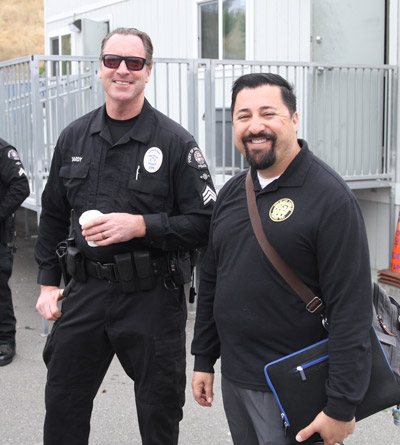
Not allowing these overweight, oversized vehicles to go up residential streets where kids are riding skateboards and bikes, and affecting the quality of life, is important to me. No one should have that right outside their front lawn. Policing that gives me great satisfaction. And then supervising what I feel is the hardest-working unit in Port Police – supervising those eight guys is both a challenge and a pleasure at the same time, for sure!
My motorcycle is my office. I’m not out to prove anything. But if you need us, my Officers are going to be ‘Johnny-on-the-spot.’ We’re going to be there. You can count on me, and my unit.”
Sergeant, thank you for your time.
Sure.
…BEHIND THE SCENES
Club Director of Marketing Summy Lam (foreground) captures Port Police’s Commercial Enforcement Unit in San Pedro. |


